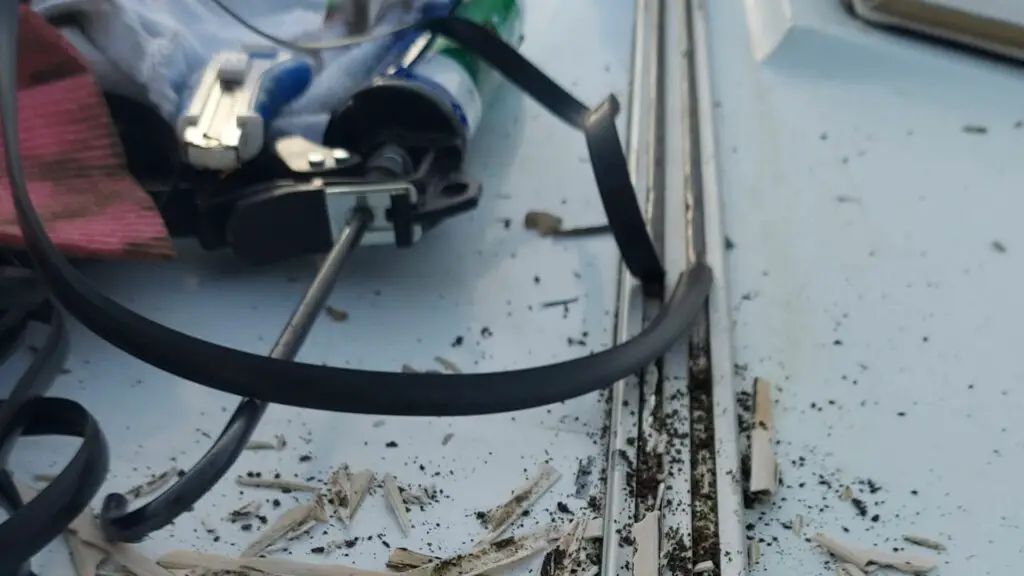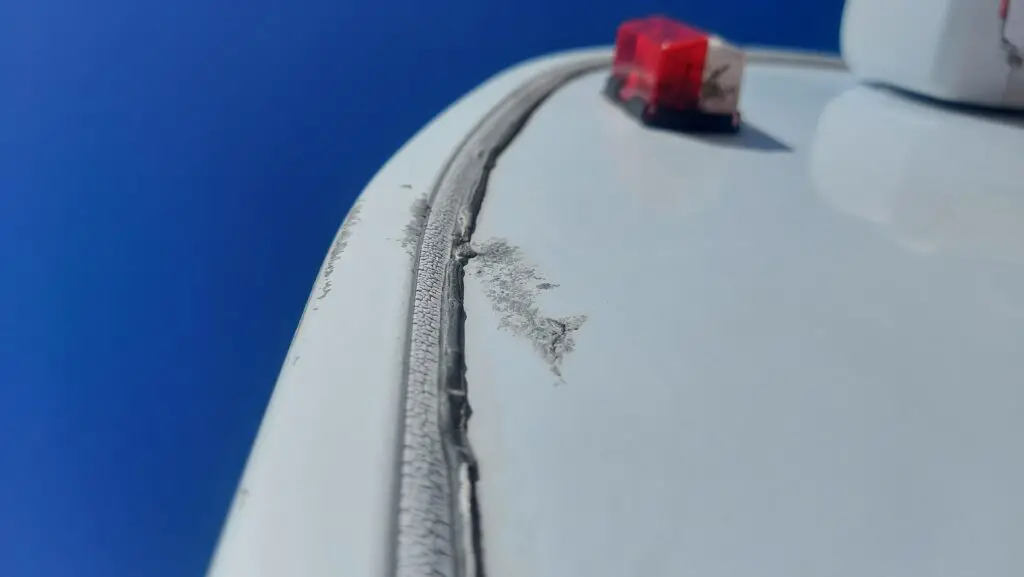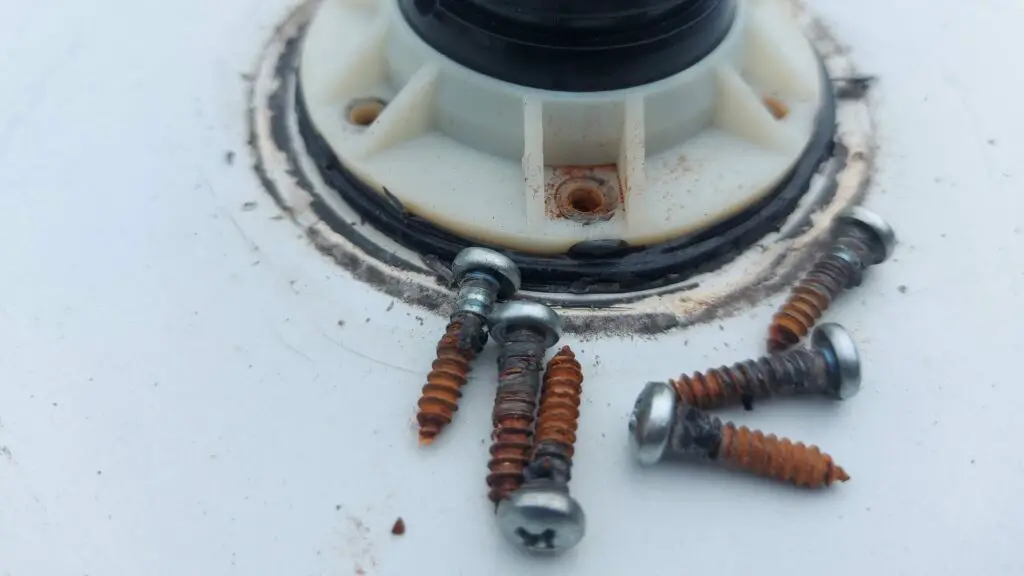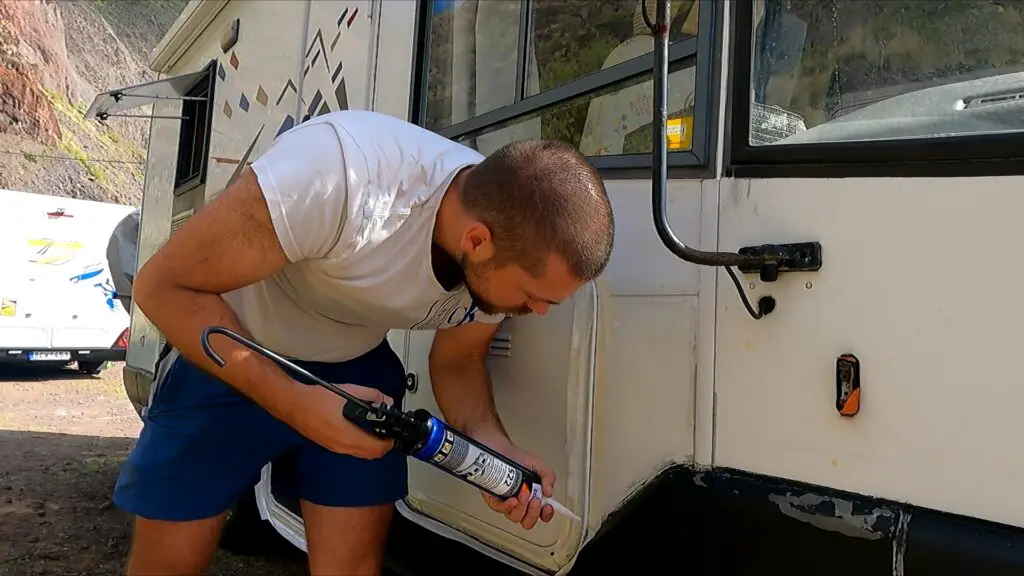This post contains affiliate links (I get a commission at no extra cost to you for purchases made through links in this post).

One of the things that can damage your RV and make your camping life miserable is a leaking roof. Some damages to the RV’s roof go unnoticed until they escalate; that’s why you shouldn’t wait until your RV’s roof is badly damaged to seal it. So, how often should you seal your RV roof?
Expect to reseal your RV roof every year; how often and to what extent will vary on the wear and tear of your roof and seals. Inspect your RV roof at least twice yearly; where and when you encounter cracks or leaks, reseal that area as soon as possible, and count on resealing the whole roof every 2-5 years.
In this article, I explain how to and how often you should check your RV roof carefully for cracks and leaks, what to look for, and how often you should reseal the RV roof. I’ll also discuss the benefits of resealing the RV roof annually, tips for resealing the RV roof, and the type of products to use. Here we go.
How Often Should You Check RV Roof for Cracks and Leaks?

RV roofs can get cracks and leaks regardless of the RV’s age or the materials they’re made of. It’s, thus, essential to carefully check your RV’s roof for cracks and leaks at least twice a year. A good routine is always to do it after you wash the roof.
Some damage to your RV roof isn’t always obvious; you only discover it when it escalates into a larger problem. Below are some benefits of checking your RV roof carefully for cracks and leaks at least twice a year:
- You can detect cracks and leaks early enough before they deteriorate.
- You can repair the cracks and leaks immediately after you detect them and thus prevent further damage and costly repairs.
Learn more about how to actually find a leak in your RV here in my other post about that specific topic.
What To Look For When Checking Your RV Roof
Your RV is exposed to bad weather and other dangers than any other vehicle parts. The roof can therefore get damaged more quickly, leading to cracks and leaks; that’s why you should check it regularly. Below are some things to look for when inspecting your RV roof:
Accidental Damage to the Roof

It’s good to look out for accidental damage to the roof as it’s one of the leading causes of a leaking RV roof. For instance, unintentional damage could rock a roof fixture and create a gap in the seals, or it could break a seal creating space for water to go through or puncture a rubber roof.
Some causes of accidental damage to an RV’s roof include:
- Falling tree branches can cause dents, cracks, or punctures on the roof.
- Heavy debris can cause dents.
- Heavy snow could eventually lead to leaks in the RV’s roof.
- Road movement and vibration can cause small cracks and tears on the roof.
- Strong winds to RV roof fixtures could loosen screws leading to leaks.
- Sun exposure can lead to the deterioration of the RV’s roof seals leading to leaks.
Faulty Sealant
Many things attached to the RV roof, such as roof vents, AC units, and aerials, are sealed using a sealant. Over time, the sealant can dry up or wear down, and when this happens, it pulls away from the seams. The pulling away can create spaces on the roof where water can pass through.
Loose Screws
Some things on your RV’s roof, such as the air conditioner and access ladder, have screws. The screws can loosen with time due to wear and tear. When the screws loosen, they can create enough space for water to leak through to the roof’s interior portions, eventually leading to severe damage to the RV’s roof.
Corrosion

If your RV’s roof is made of metal or has some metal parts, it’s best to look for corrosion on the metal. Water damage to the roof can lead to corrosion of the metal. So, look out for signs of corrosion, such as discoloration, rust, or flaking off of the metal.
When you remove any screw from the interior and the exterior, always check if the screw is rusty; if it is, you likely have a water leak somewhere near.
Water Damage
Look out for water damage in your RV; water damage could appear in different forms. For instance, look out for the following:
- Peeling wallpaper
- Damp patches on the walls
- Discolored streaks running down the walls
- The smell of mold and mildew (smells like wet newspapers)
How Often Should You Actually Reseal Your RV Roof?
As I stated earlier, it’s advisable to reseal your RV roof yearly. Some RVers may feel that is overkill, but it’s pretty realistic; If you wait until you notice a leak in the interior, it is already too late, and you will have extensive water damage. Resealing the roof yearly is a preventative maintenance procedure that helps keep your RV in good shape.
Remember that there are different levels of resealing your RV roof! The once-per-year is more of a guideline to when you most likely will notice a few cracks in the old sealant, and you seal that small area. It’s a quick and easy job done in less than an hour if you have everything.
To learn when you can use new lap sealant over old one, you need to read my other article about it, which will bring you a lot of clarity as to when to do what with your RV roof.
The “proper” RV roof resealing is a much more extensive job that will most likely include removing all old sealant, putting on new and maybe even putting on a new protective coat over the whole roof, and this you won’t need to do every year, more like every 2-5 years depending on the wear and tear.
At some point, you maybe even remove all fixtures, windows, hatches, and everything that is attached to the RV and replace the butyl sealant tape! An even more extensive job that might only be necessary after 15-25 years or so.
The type of environment you drive through or camp in regularly can affect your RV’s roof. For instance, weather conditions, like heavy snow, strong winds, and rain, can damage your RV’s roof. Also, debris, tree branches, and small animals like raccoons can damage the RV’s roof.
So, it’s best to reseal your RV’s roof annually according to its needs, as it’s better to be safe than sorry.
The Benefits of Resealing Your RV Roof Annually

As I have stated above, resealing your RV’s roof yearly to some extent is an excellent preventative procedure. It’s just a matter of time before the sealant starts to degrade and needs to be replaced.
Below are the benefits of resealing your RV roof every year.
Resealing Prevents Water Damage in the RV
The main reason for resealing your RV’s roof yearly is to prevent water damage. RV roofs are prone to leaks because they have seals, screws, and seams where water can pass through. Water leaks can cause untold damage to the RV, including:
- Damage to electrical wires
- Damage to appliances
- Damage to your belongings
- Growth of dry rot, mold, and mildew
Resealing Annually Strengthens the RV Roof
Resealing the RV’s roof strengthens it, especially as the RV ages. The sealant forms a strong barrier on the roof and also prevents the roof from becoming brittle or drying out. The sealant thus reinforces the roof and keeps it watertight until you reseal it the following year.
It Extends the Life of the Roof and of the RV
Although your RV’s roof can withstand harsh weather conditions, the materials making the roof will still wear out as time goes by. When you reseal your RV’s roof annually, you extend the roof’s life. Suppose you prolong the roof’s life; in that case, you also extend the life of your RV.
Annual Resealing of the RV Roof Gives You Peace of Mind
If you are an RVer, knowing that your RV is always ready for use gives you satisfaction and peace of mind. That’s what resealing your RV’s roof does to you. When you reseal your RV roof annually, you get peace of mind knowing that your RV is safe and secure whether you go camping or park it outside your home.
I have so many times been sleeping in my RV worried sick during heavy rains knowing that I still hadn’t resealed my roof even though it really needed a big resealing job as it is 26 years old and poorly maintained by previous owners.
Tips for Resealing Your RV Roof Annually
When resealing your RV roof, it’s essential to do it correctly for the best results. You can either hire the services of a professional or do it yourself. Below are some tips for resealing your RV’s roof on your own:
- Always scrape off any loose sealant on the RV’s roof: If some parts of the old sealant are peeling, flaked, or brittle, it’s essential to scrape them off before you apply the new one. Scraping off the damaged old sealant makes a new application look beautiful and neat.
- Clean the RV’s roof: It’s best to clean the RV’s roof before resealing to remove any dust, dirt, debris, or other foreign objects. If you are curious as to whether or not you can use a pressure washer for the job, you need to read this.
- Remove any mildew or mold on the RV’s roof: Removing the mold and mildew prevents it from thriving after resealing the roof.
- Allow the roof to dry: It’s essential to allow the roof to dry entirely before resealing it. The reason is that most RV roof sealants don’t work efficiently on wet roofs.
- Choose the suitable sealant for your RV roof: There are different sealants for RV roofs based on the materials making the roofs. Choosing the appropriate product for your RV’s roof is therefore crucial.
- Always follow the manufacturer’s instructions: Each sealant comes with the manufacturer’s instructions, and it’s good to follow them carefully when resealing your RV’s roof for the best results.
- Reseal the roof at the appropriate time: The best time to reseal your RV’s roof is early morning or early evening, as the weather is cool. Some RV roof sealants can dry quickly when exposed to the sun. In addition, do it during dry weather, as some products could take more than 24 hours to cure completely.
- Always inspect your work: It’s good to inspect the roof after resealing it to identify poorly done areas. Once you identify the imperfections, you should rectify them immediately.
Types of Products You Can Use to Reseal Your RV Roof

You can use numerous products to reseal your RV roof; you can be spoiled for choice. Remember, the product you choose should be suitable for the material of your RV roof. So the first thing you need to figure out is what type of roof you have, which you can do in my other article, where I talk about the 6 different RV roof types and how to tell them apart.
If you already know what type of roof you have on your RV, you can still find the article above of great use, as I list multiple products that are suitable with each roofing material in that article.
RV Roof Products That Work on all 6 RV Roof Types
In the table below, I have listed the best and most important products for you that will work on all different RV roof types!
| Main Application: | Product With Amazon Affiliate Link: |
|---|---|
| Butyl Tape seals inbetween fixtures and roof. | Dicor Butyl seal tape |
| Emergency Seal Tape is great for a quick fix over a small surface. | Eternabond tape 4″x25′ |
| Mounting Adhesive, I have mounted my solar panels directly to my roof with this. | Sikaflex 252 Adhesive |
| Roof Coating, basically, painting your roof with it will form a protective seal and make it look new. | Liquid Rubber RV Roof Coating |
| RV Cleaner is a special RV roof cleaner for all RV roofs. | Dicor Rubber RV Roof Cleanser Spray |
| RV Cleaner, special RV cleaner for all surfaces. | 303 RV Wash & Seal – Clean |
| All-Purpose Cleaner works for all RV exterior surfaces. | Simple Green |
| Primary Sealant can seal pretty much everything like a PRO on your RV | Sikaflex 221 sealant |
| Secondary Seal, Forms a secondary seal on a horizontal surface (Roof) easy to use. | Dicor 501 Self-Leveling Lap Sealant |
| Secondary Seal, Forms a secondary seal on a vertical surface (Walls). | Dicor 551 Non-Leveling Lap Sealant |
If you want to make sure that you will use the sealants that RV manufacturers use, you can check out this article I wrote on that; it will also give you a better understanding of how to use Sikaflex as well as Dicor Lap Sealant and the Eternabond tape.
If you are not sure how to reseal your RV roof, remember that there are some differences depending on what type of roof you have, and the difference you can read about in this other article I have made for you.
Conclusion
Your RV’s roof deserves special care as it protects the entire unit. The roof is prone to damage as it encounters vibrations, scorching sun, rain, snow, tree branches, and debris. If you’d like to get the most out of your RV, it’s best to maintain the roof by resealing it regularly.
RV experts recommend inspecting your RV’s roof at least twice a year. By doing so, you identify and solve even the slightest problems before they escalate. In addition, resealing your RV’s roof once a year is recommended to keep the RV in tip-top condition at all times.
